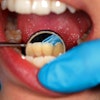A study published in Clinical Cancer Research validates a noninvasive screening method with future potential for detecting human papillomavirus (HPV)-positive head and neck cancers, according to a press release from the American Association for Cancer Research.
In the study, researchers at Johns Hopkins University used oral rinses and targeted DNA amplification to track and identify oral HPV infections in patients with HPV16-positive and -negative head and neck squamous cell carcinomas (HNSCC) before and after therapy.
Findings showed detection of high-risk HPV infections in patients with HPV16-positive HNSCC for up to five years after therapy, indicating a high rate of persistent infection and reaffirming the connection between high-risk types of HPV and HPV-positive head and neck cancer.
"There is no question of cause," said the study's co-author Maura Gillison, M.D., Ph.D., an associate professor of oncology. "It has now become a question of tracking the infection over time to identify those at risk of developing HPV-positive cancer, and for those who have had it, the risk of recurrence and risk of transmission. This is the first study in which we have been able to track the disease and related oral infections for an extended period of time."
Researchers obtained oral rinse samples from a group of 135 patients with head and neck carcinomas. Tissue analysis showed that 44 of these patients had HPV16-positive tumors. Both the tissue and oral rinse samples were genetically sequenced to specify the HPV variants in each. Patients with HPV16-positive tumors were significantly more likely to have oral HPV16 infections, with an almost tenfold increase prior to therapy and a 14-fold increase after. Patients with high-risk oral HPV infections prior to therapy also had a 44-fold increase of post-treatment infection.
Findings showed no significant odds of tumor recurrence among those with post-treatment infections and no association between these infections and the development of second primary tumors at two years. However, this possibility cannot be excluded as longer observation may be needed.
Future studies will be able to use the data and methodology to further explore the connection between HPV and head and neck cancer formation, as well as the biological factors, such as HLA type, that are involved, Dr. Gillison said.















